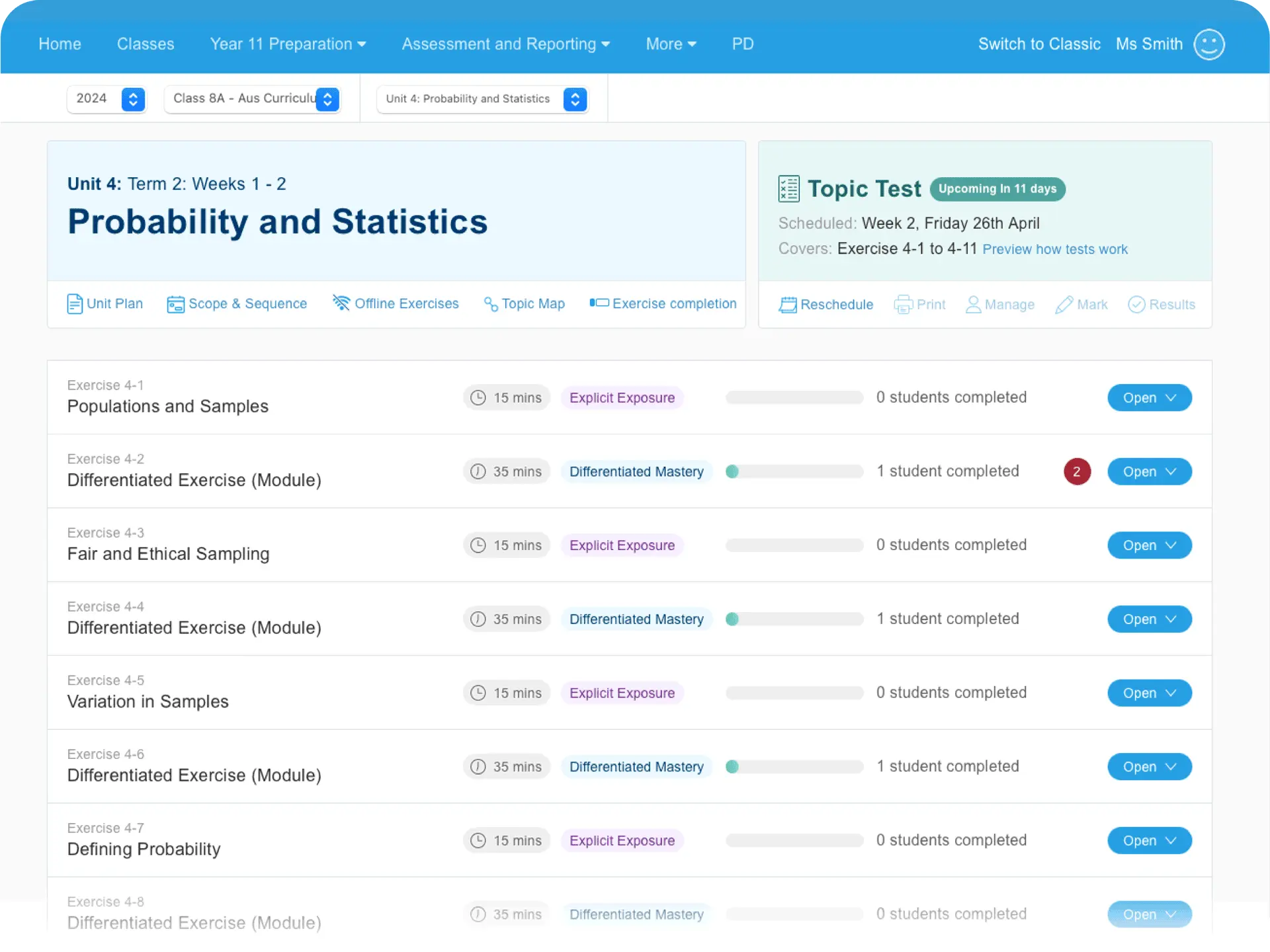The 2020 school year has been one of the most challenging in Australia’s history — and we’re not even halfway through it. Throughout Term 1 and 2 almost 4 million students were forced to learn from home, with millions more attending school through difficult and sometimes scary times.
The challenges that teachers across the country have faced are truly unprecedented. And adapting to a new way of learning has been hard for students too. Not to mention all of the parents, who had to work from home and support their kids at the same time.
With students now heading back to school, we’re left with one burning question — what effect have school shutdowns and disruptions had on student learning? Have students fallen behind? And if they have, how far?
Gaps weren’t inevitable — they already existed
Instinctively many teachers will already know the answers to the above questions. Of course some students have fallen behind.
According to this Grattan Institute report, students tend to learn less when they’re not in the classroom, and new data from Australian teachers supports this in relation to COVID-19.
In a national survey of teachers by Pivot, most believed that students learnt at about 50-75% of their regular pace during school shutdowns. Those teaching in disadvantaged schools were less confident, reporting that their students learnt only 25-50% of what they typically would.
A similar survey of NSW teachers supported these findings, with 35% of teachers in high-SES schools reporting that they were confident that students were learning well during remote learning. For low-SES schools, only 18% of teachers felt the same.
There are many reasons why students have fallen behind.
Most are tied to the simple fact that they just haven’t been in the classroom with their teacher to support them. Learning from home will mean distractions, using new technology (if there is technology at all) and limited access to help when it’s needed.
Despite best efforts, teachers moved to remote schooling without any evidence of how to do it well. There was a rush to move online and without a benchmark for best practice, there wasn’t much to go on. And just as teacher’s weren’t prepared, neither were students. More than 70% of teachers in NSW felt that their students were not prepared to work at home.
Plus, it can be really difficult for teachers to deliver all of the content they would typically cover in-class in a remote environment. Let alone, try to make that remote content personalised. For a lot of teachers, having their students complete even half of their work was a win. Keeping students as close to on track as possible was the goal. So it comes as no surprise to teachers that when students return over the coming weeks, they’ll do so at a range of different levels.
But this isn’t new. The reality of education is that students don’t master every concept that’s introduced to them — whether they’re in the classroom or not. Every student has gaps in their mathematical understanding along with concepts that they’ve mastered.
In fact, research shows that a typical Year 7 classroom has an eight year spread of ability ranging from students who struggle to count, to students who have a deep mathematical understanding and lack challenge from aged-based content.
So if students had gaps when they headed into school shutdowns, what do those gaps look like now? And will they affect their learning moving forward?
To close, or not to close…
According to new reports, these gaps have widened for some students during shutdowns.
A series of five reports commissioned by the Federal Education Department found that up to half of Australian students could be adversely affected by the switch to remote learning.
The reports, which were conducted by leading universities and educational institutions, examined the possible implications of school shutdowns, with a particular focus on vulnerable students.
In one report by the Mitchell Institute at Victoria University, Professor Stephen Lamb found that vulnerable students could fall six weeks behind in numeracy if online delivery lasts for two terms.
In another report by the Grattan Institute, the equity gap is estimated to grow at triple the rate in a remote learning environment. Projections further suggest that even in situations where remote learning has worked well, many disadvantaged students are likely to have learnt at approximately 50% of their regular pace. So over two months of remote learning, it’s estimated that the achievement gap widened by 7%, which is about 6 additional weeks of learning.
The problem with students falling behind in maths isn’t just that they need to catch up. It’s the fact that students learn maths on a continuum. So students must understand one concept before they can move on to the next. According to the ‘Matthew effect’ students who miss concepts or skills can find it difficult to master new concepts down the track. Struggling students then become less motivated and problems compound.
Because if they don’t master the foundations, learning new concepts further along can be difficult, or even impossible.
That’s not to say that continuum learning is happening perfectly in every classroom. Our education system actually makes it quite difficult. When teachers are forced to move quickly through curriculum students are often left behind and never fully catch up. And we can see that this is happening from Australia’s results in national and international tests that show a decline in numeracy proficiency.
So teachers and Learning Teams everywhere now need to make some really difficult decisions about what to do next. How will they address the next education challenge of 2020 — learning gaps? Should they accept these unprecedented times as just that, and move forward as best as possible? Or stop and address the gaps that have widened among their students?
The former seems like the easier option, especially considering the limited time and resources teachers have to work with. Not to mention everything they’ve already been through this year. But cutting our losses this term won’t guarantee smooth sailing moving forward. Those gaps are going to create problems for students. So next year when you meet your new class, you’ll just be meeting a new set of gaps that needs to be addressed.
Yes, schools and students everywhere will be facing this problem. But the impact that these gaps can have on student outcomes is significant.
Research shows that students who achieve low numeracy scores as early as Year 3 will never catch up to their classmates — falling even further behind by Year 9.
Maths Pathway data has also found that in a traditional classroom (without the disruptions of a pandemic) an average of just 9% of students will reach or exceed the expected curriculum standard for their year level. This means that by the time these students enter Year 10, the vast majority are unprepared to continue their studies in maths related fields.
We know we shouldn’t ignore the gaps — we really do. But how can we actually address them with the time and resources we have?
A way forward
The approach schools take needs to be effective. Wasting time on practices that make little difference to student growth just isn’t going to cut it.
So rather than rushing back over content, or cutting out chunks of the curriculum, schools should consider personalised learning.
Targeting teaching to each student’s individual point of need isn’t just post-pandemic. It’s an approach to teaching that allows students to work at their level, making progress regardless of their starting point. And it works.
This is exactly why the teachers behind the Maths Pathway set out to develop a Learning and Teaching model that enabled truly personalised learning in the classroom.
How? The model uses advanced diagnostics and ongoing formative assessments to provide granular data on each student’s gaps and competencies. By identifying each students’ learning profile — what they have mastered, what they are ready to learn next, and what gaps may exist — Maths Pathway gives students the curriculum mapped content they are ready to learn.
That means students can work on closing gaps in their learning and mastering new concepts. They can work within their Zone of Proximal Development, being challenged enough to remain engaged but having the foundation knowledge experience success. Top achieving students can move beyond the restrictions of aged-based content and students who have previously struggled can master the maths they’re ready for.
In 2020, more than 67,000 students experienced personalised learning with the Maths Pathway model. Our 2020 Impact Report shows that these students also learnt 1.26 years of maths in 12 months — almost double the average of 0.65 in a traditional class.
This further shows that students who have fallen behind during the pandemic have the opportunity to cover more content with Maths Pathway, rather than falling further behind.
In fact, students who were using Maths Pathway during school shutdowns have managed to maintain the same growth rate. You can read more about it here.
This isn’t surprising. We know that when students experience this type of teaching they often don’t just progress in their learning, they become more engaged. When they’re learning the maths that they’re ready to learn, students can experience success and become more confident in their mathematical abilities, leading to more interest in the subject.
Importantly, the Maths Pathway model supports teachers to deliver personalised learning without additional administration or time needed. The model leverages technology to deliver ongoing formative assessments and curriculum mapped content, which consists of carefully scaffolded learning activities that work to build students’ understanding, fluency, problem solving and reasoning skills. Leaving teachers more time to focus on what matters — teaching their students.
So if you and your Learning Team are wondering what to do about the gaps that have formed in student learning during COVID-19, please reach out to us. Our team can talk you through our model and how it can work at your school. Complete the form below and someone will be in touch. Or use the links below to learn more about how our model works.
Learn more about the Maths Pathway Model
See the Maths Pathway model in action at Redcliffe State High School

